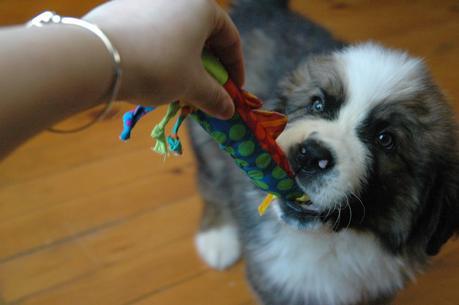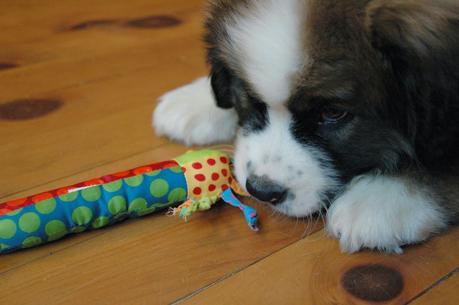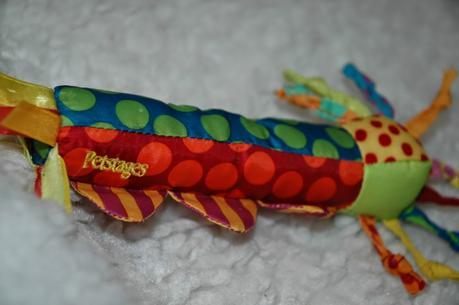
Photo by Stacey McIntyre-Gonzalez Copyright©
Puppy play biting: How to teach a teething puppy not to biteBy Stacey McIntyre-GonzalezIt is a painful problem that every puppy owner faces: play biting. Puppy owners are far too familiar with the feeling of an adorable fuzzy puppy clamping on to their sensitive skin with those tiny, deadly and razor-sharp puppy teeth. But play biting is a natural thing for a puppy- she is trying to use her mouth to learn about the world around her. It starts with the other pups in her litter. They bite when they play fight but when one pup bites too hard the other pup will yelp loudly and stop playing. From the beginning puppies are learning the boundaries of biting and it is a lesson that needs to continue when they leave the litter to join their human family. Biting too hard is a behavior that needs to be corrected right from the beginning if the puppy is going to be able to have good relationships with other people and dogs. Founder of The Academy For Dog Trainers Jean Donaldson published an article in 2007 for the Calgary Humane Society about aggressive behavior in canines. She educates about acquired bite inhibition (ABI) which “is the degree of pressure a dog exerts with his jaws when he bites, and likely the most significant prognostic indicator in aggression.” Puppies must be taught not to put force behind their bite because according to Donaldson “ABI has proven virtually impossible to modify in an adult dog.”Click here to read the rest!

Hazel loves the tassels.Photo by Stacey McIntyre-Gonzalez Copyright©
Although some breeds are known for being mouthier than others all puppies play bite- that is a fact. So my new puppy Hazel- a Saint Bernese with one leg shorter than the other- is no exception. Although the mountain dog mix is known for being a gentle giant as puppies Saint Bernard dogs and Bernese mountain dogs are just as mouthy as any Chow Chow or Akita. So Hazel’s piercing puppy teeth have been sinking into my hands, arms and feet since we brought her home. “Between four and six months, most puppies will pass through a teething phase,” Cesar Millanstates in his book How To Raise The Perfect Dog: Through Puppyhood and Beyond. In his book Millan shares his experiences raising four puppies of different breeds. The second teething phase- which takes place when the adult teeth are coming in- will happen at six to ten months of age. Hazel is only 10 weeks old but she acts like she is in a full blown teething phase.Chewing doesn't just happen during the teething stages- Millan states in his book that chewing also “relieves anxiety or boredom.” A puppy will chew no matter what so it is most important to project a dominant energy when correcting the behavior. “If you are worrying about your own discomfort or injury, you will be projecting a weak energy to the puppy, which she will naturally try to take advantage of,” Millan states in his book. So first things first I had to remain calm, assertive and in control.I started by mimicking the yelping that her siblings would have done when she bit them too hard. I would yell “OW” really loud and stop playing with her. If she persisted I would turn my head away from her which is a way that a dog sends a calming signal to another dog. This usually makes her groan and move away from me. I wait a little while and then I offer her a toy, bully stick or something else more suitable for Hazel to chew. She has taken to chewing the corners of my area rugs so I make sure she always has available toys to play with. I also spray the rugs with Bitter Apple to deter her from that spot. If she is chewing something she shouldn't I offer her a toy. She has almost been completely broken of chewing on the rugs but unfortunately she still loves chewing on my hands and feet.
Photo by Stacey McIntyre-Gonzalez Copyright©
Anyone who has had a puppy knows that baby teeth are super sharp. By allowing a puppy to chew on hands and feet at a young age the owner is conditioning her to believe that the behavior is acceptable. It may start out as cute and sometimes when Hazel looks up at me and bites onto my hair she looks absolutely adorable. But Hazel could end up being 120 lbs and her biting will not be so cute then.Since “OW” is not working that well I tried giving Hazel the corrective grab to the scruff that Millan teaches in the book. He has this bad puppy habit listed in his book as “Common Problem 4” among owners surveyed and found that 24% stated ”nipping” a big problem while 19% said “mouthing” was their main puppy concern. As far as “chewing” on objects 38% of puppy owners surveyed listed this as a top issue making it the “Common Problem 2” in Millan’s book.With Hazel grabbing the scruff just didn't have the desired effect- neither did offering her a toy instead of my forearm. She just always went back to chomping on one of my extremities. Currently I am trying something completely new to help prevent Hazel from play biting. When she bites really hard I yell “OW” and tell her no. I take my hand away for 10- 20 seconds. Then I offer her the back of my hand and say “kisses” gently. When Hazel licks my hand or mouths it very lightly I reward her- either with a treat, toy or affection. So far this has been working and Hazel now enjoys giving kisses. Once I felt she was grasping it I started working it into the tricks she is learning. Sometimes instead of asking for her paw after she sits I will ask her for kisses and reward her when her little tongue touches the back of my hand.
The Cool Teething Stick by Petstages that Hazel loves so much.Photo by Stacey McIntyre-Gonzalez Copyright©
Hazel is only 10 weeks and is a work in progress but we are getting there- I will keep you all posted on her progress. The most important part- and the hardest part- is to not take anything Hazel does personally. Since Hazel is 10 weeks here are my top 10 techniques you can try to reduce play biting in your puppy.1. I truly believe all puppies should be in a puppy class of some sort once they have had their third round of vaccines and their immunity is up. Puppy obedience classes will solidify you as the dominant human or “pack leader.”2 2. Don’t correct the behavior with physical corrections that may scare your puppy or encourage her to play rough. Try looking away from your puppy- this is a calming signal in dogs.3 3. Socialize your puppy with as many other vaccinated dogs as possible- especially older dogs or other puppies that will assert their dominance.4 4. Try using a natural pet repellent spray like Bitter Apple on objects in the home or your hands or clothing. When the puppy reacts to the taste of the spray say your correction. “Back off!” 5. Avoid jerking your hands or feet away from your puppy when she mouths. Also avoid waving your hands or fingers at your puppy, slapping the side of her face or tapping her nose to play. 6 6. Find a teething toy with different textures and flaps that are interesting to your puppy- like Hazel’s favorite toy from Petstages that you can freeze. 7. If your puppy tries to bite your hands when you pet her try holding a bully stick or a treat in the other hand. 8. Give your puppy another option: a toy to chew instead of what she was chewing. Always have toys accessible for your puppy and carry a toy in your pocket.9 9. Teach your puppy to fetch an item. This will help stimulate her mentally while giving her something else to carry in her mouth. 1 10. Yelp or yell a loud correction when your puppy bites you really hard. Take your hand away and ignore your puppy for a short while. Once your puppy calms down resume play and repeat until your puppy starts to be gentler with her bites. This method and is best described on PetMD